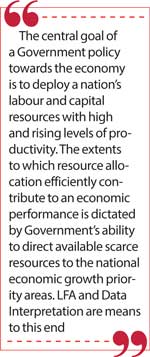Monday Jan 05, 2026
Monday Jan 05, 2026
Wednesday, 15 May 2024 00:26 - - {{hitsCtrl.values.hits}}

Policymakers must determine the level of full capacity national output in understanding the state of the economy and in making informed decisions regarding monetary and fiscal policies
 The Sunday Times of 28 April 2024 reported that plans are underway to lift the restrictions on the import of motor vehicles because a committee of Treasury Officials has stated that in the absence of duties on motor vehicle imports the country would not meet the revenue targets set by the International Monetary Fund. The news report states further that the trade-off is an $ 800 million drain on foreign reserves against the earning of a SL Rupee denominated tax revenue of Rs. 340 billion. Whilst accepting that there would be different views re the logic of this trade-off, I see this as a situation which calls for Limiting Factor Analysis (LFA).
The Sunday Times of 28 April 2024 reported that plans are underway to lift the restrictions on the import of motor vehicles because a committee of Treasury Officials has stated that in the absence of duties on motor vehicle imports the country would not meet the revenue targets set by the International Monetary Fund. The news report states further that the trade-off is an $ 800 million drain on foreign reserves against the earning of a SL Rupee denominated tax revenue of Rs. 340 billion. Whilst accepting that there would be different views re the logic of this trade-off, I see this as a situation which calls for Limiting Factor Analysis (LFA).
Limiting Factor Analysis is a strategic management tool available to all, and used frequently by corporates, in identifying and addressing constraints which prevent a business from operating at full capacity and in making choices between alternatives when a specific factor of production is in limited supply. The limiting factor may be in the form of installed capacity, available capital, market demand, skilled labour, available land et cetera or a combination of these.
Presently, Sri Lanka’s most serious limiting factor is the availability of foreign exchange to purchase raw materials, services, equipment, and other production/marketing enablers. In this background, decision makers, at both a corporate level and national level, must deploy LFA in determining which of the alternatives competing for the limited foreign exchange gives the biggest bang for the buck, i.e. which alternative delivers the highest contribution/benefit for each unit of foreign exchange.
I recollect a period in Zambia, in the early nineties, where foreign exchange was in limited supply and businesses had to bid for foreign exchange at weekly auctions to cover their needs. In such a scenario, corporates had to calculate which product, or combination of products, yielded the highest return for every unit of foreign exchange used even though some of the relegated products had higher overall contributions when there was no limiting factor. In times of multiple constraints, which were more the norm than the exception, corporates had to use linear programming to arrive at the optimum combinations. Such was the use of data and technique in making complex decisions. I wonder whether decision makers in Sri Lanka employ such thinking and analysis. Did the committee of Treasury Officials consider limiting factor implications when recommending the lifting of restrictions on motor vehicle imports? Do corporate leaders consider limiting factor implications in decision making?
Countries, just like individuals and businesses, face scarcities and must make choices. In economic parlance, a Production Possibilities Curve (PPC) represents the maximum quantity of goods and services which can be produced, singularly or as a mix, by a country using the full extent of available resources. In current Sri Lanka, if we use our limited foreign exchange in increasing tax revenues through consumption to meet International Monetary Fund (IMF) targets and/or to finance domestic expenditure, we will have lesser foreign exchange available to finance imports required to increasing manufacturing output and/or the volume of services in areas such as tourism, shipping and information technology and to upgrading the quality of education, healthcare, public transport et cetera. Similarly, if land is allocated for industrial, tourism or other purpose there will be lesser acreage available for agriculture and for preservation of nature.
 When there are finite resources, Sri Lanka, like any other country, must make choices and in making such choices, it must compare the marginal costs and marginal benefits of each alternative. In making a choice on the use of our limited foreign exchange, I would expect the matter to have been the subject of intense scrutiny, robust discussion and even dissension. Some dissension is always good in making decisions. Judging by the nonchalance with which recommendations have been made at a national level on a critical issue such as the use of our very limited foreign exchange, I suspect that such scrutiny and discussion have not happened in this instance and do not happen in many other instances too.
When there are finite resources, Sri Lanka, like any other country, must make choices and in making such choices, it must compare the marginal costs and marginal benefits of each alternative. In making a choice on the use of our limited foreign exchange, I would expect the matter to have been the subject of intense scrutiny, robust discussion and even dissension. Some dissension is always good in making decisions. Judging by the nonchalance with which recommendations have been made at a national level on a critical issue such as the use of our very limited foreign exchange, I suspect that such scrutiny and discussion have not happened in this instance and do not happen in many other instances too.
This leaves me with this uneasy feeling that our national decisions are made, at times, to cater to political whims and fancies of those in power than to the long-term interest of the country. Another scripting of the old age tale of the current generation making merry, in the immediate term, at the expense of future generations. You will no doubt recall that this ‘robbing Paul to pay Peter’ approach was a key issue at the heart of the ‘Aragalaya’, i.e. the agitation for a system change.
It is firms, not nations, which create competitive advantage
“National prosperity is created, not inherited,” and “It is firms, not nations, which create competitive advantage”, argued Michael E. Porter in his seminal book, “The Competitive Advantage of Nations”. Porter concluded that firms, and thereby countries, achieve competitive advantage through continuous acts of innovation and upgrade. He concluded that the capacity and hunger of firms to innovate is affected by four broad attributes of a nation, these being Factor Conditions, Demand Conditions, Strength of Related and Supporting Industries and the Strategy, Structure and Rivalry of the Country’s Firms. An honest, unemotional, and critical review of Sri Lanka’s economic journey since independence reveals that successive Governments have failed miserably in maintaining, enhancing, and leveraging these attributes in facilitating sustainable development and competitive advantage. The Government, rather than being an enabler, catalyst, and challenger, has been a competitor of the private sector even in areas where there had been no market failure.
In his dissertation, Porter describes how nations such as the United States of America, Germany, Japan, and South Korea achieved international competitiveness by creating environments where local companies were encouraged to compete and turn disadvantages into advantages by innovating around the problem. Other than in a few isolated areas such as the manufacture of garments for export, ports and shipping and information technology, Sri Lanka has neither utilised its available capacity effectively nor has it upgraded its factors of production in a proactive manner in establishing competitive advantage.
Just as businesses use measures such as capacity utilisation, capacity efficiency, cross-selling synergy and continuous learning et cetera as indicators of performance effectiveness, nations, too, must regularly determine whether they are operating at full potential and whether their limited factors are utilised, sagaciously, to yield the optimum return. I deliberately used the word ‘optimum’ rather than ‘maximum’ to allow for the consideration of non-quantifiable strategic factors in the decision. These assessments and corrective actions arising thereof must include Limited Factor Analysis if they are to be efficacious. Corrective actions arising from such a determination must be data driven and must not be based on political expediency.
Sri Lanka operating well below full potential because of constraints
Published reports show that Sri Lanka is operating well below its full potential because of various constraints. Some natural and some man-made. The United Nations Conferences on Trade and Development’s (UNCTAD’s) Productive Capacities Index (PCI) 2023 ranks Sri Lanka at 122 of a total of 194 countries. The PCI is a measure of a country’s ability to produce goods and services through a combination of productive resources, entrepreneurial capabilities, and production linkages. UNCTAD defines * Productive Resources as factors of production including capital, both financial and physical, with the latter comprising land, machinery and equipment and other infrastructure, * Entrepreneurial Capabilities as the skills, knowledge, and information which enterprises possess in the forms of entrepreneurship, entrepreneurial capabilities, and technological capabilities, and * Production Linkages as flows of knowledge, technology and information, and productive resources including human resources, among productive units of goods and services operating in different industry sectors and ranging in size from micro, small and medium to large. The ownership of the productive unit can be domestic, foreign, public, or private.
 Sri Lanka’s PCI is calculated at 43.3. Heading the list are Denmark, Australia, United States of America, Netherlands, and New Zealand with PCIs of 70.3, 69.8, 69.2, 68.8 and 66.9, respectively. China with a PCI of 60.7, Singapore with a PCI of 52.5 and India with a PCI of 45.3 are ranked 26th, 57th and 108th respectively. The indicators evidence that Sri Lanka’s ability to produce goods and services through a combination of productive resources, entrepreneurial capabilities, and production linkages is below average.
Sri Lanka’s PCI is calculated at 43.3. Heading the list are Denmark, Australia, United States of America, Netherlands, and New Zealand with PCIs of 70.3, 69.8, 69.2, 68.8 and 66.9, respectively. China with a PCI of 60.7, Singapore with a PCI of 52.5 and India with a PCI of 45.3 are ranked 26th, 57th and 108th respectively. The indicators evidence that Sri Lanka’s ability to produce goods and services through a combination of productive resources, entrepreneurial capabilities, and production linkages is below average.
UNCTAD’s Productive Capacities Index is recognised, globally, as a dynamic, and practical, tool which assists countries, particularly developing countries, to diagnose the areas where they may be leading or lagging and to highlight countries where corrective efforts are needed. It provides the inputs for a roadmap of future policy actions and interventions under each of its eight components, these being Human Capital, Natural Capital, Energy, Information/Communication and Technology, Structural Change, Transport, Institutions, and the Private Sector. UNCTAD observes that building the economic resilience of developing countries remains a daunting challenge and requires a shift from the current fragmented and project-based interventions towards coherent, program-based, and economy-wide approach in removing binding constraints on development. Sri Lanka’s forward planning must be founded on LFA, diagnostic reports such as UNCTAD’s PCI, IMF’s Technical Assistance Report-Governance Diagnostic Assessment et cetera and on the expertise resident in Sri Lanka’s Public Service. Often, the advice of such experts is not sought and when advice is given it is overruled by ‘know-it-all’ political leaders who pursue their selfish motives than the best interest of the country.
In very simple terms, the PCI represents the maximum level of output an economy can achieve in a specified period without causing unsustainable imbalances or undue strain on its productive capacity. An economy is deemed to be operating at its full capacity if it is using all its labour, capital, and other resources and there is no output gap. Whilst a negative output gap denotes unused productive potential, a positive output gap indicates that the economy is operating above its rated capacity. There are moments of time when economies exceed their capacity. Although this may be considered as positive, temporarily, a prolonged period of above capacity operations may be unsustainable and may lead to inflationary pressures.
Policymakers must determine the level of full capacity national output in understanding the state of the economy and in making informed decisions regarding monetary and fiscal policies. We know that achieving full capacity output is not always possible or practical in the medium to long term because economic conditions constantly evolve and are subject to various external and internal factors. This is where LFA and a current knowledge of the utilisation of productive capacities play a differentiating role. These are the features of decision making which separate the winners from the ‘also rans.’
What contributes to an economy reaching full capacity output?
The key factors which contribute to an economy reaching its full capacity output include:
(1) The labour market. The labour market plays a significant role in an economy. Typical questions are – Is there full employment? Are all available labour resources participating in the workforce? et cetera. The labour market is affected by both macroeconomic factors and microeconomic factors. At the macroeconomic level, supply and demand are influenced by domestic and international market dynamics, as well as factors such as immigration, the age of the population, and education levels. The popular measures which apply in this regard are unemployment rates, productivity, participation rates, total income, and gross domestic product, to name a few. At a microeconomic level the supply and demand of labour is influenced by what individual firms are willing to pay, the number of hours which employees are willing to spend and the compensation they receive for their services,
(2) Capital utilisation. This represents the intensity with which a national economy (or sector, or firm) makes use of its capital resources, both physical and financial. Capital utilisation is determined by economic decisions and is frequently affected by expected and unexpected causes. The demand for products and services, the volatility of prices of inputs such as labour and raw materials and cost of financial capital have a bearing on the use, or nonuse, of physical and financial capital,
(3) Use of technology and innovation in increasing productivity. The relationship between technological advancements/innovation and economic efficiency/economic equity is complex and dynamic, and often involves a choice between alternatives. There are occasions where technologies which increase efficiency also increase inequality. In such instances, there is a need for the use of LFA and other tools in assessing the costs and benefits of the alternatives. Such assessments will be the base in crafting of appropriate policies and interventions to maximise social welfare and minimise the adverse effects of technological change,
(4) Utilisation of natural resources. Development in a country abundant with natural resources is easier than in a country which does not have as many. However, there are a couple of important aspects to consider. One being the optional value of nature and the other being the aesthetic value of nature. Re optional value, if we, as humans, continue to use the limited natural resources lavishly without any steps of renewal, there is a high chance of our stock of flora and fauna being depleted causing disruption to the equilibrium of nature. Again, the impact of today’s actions of the current generation will be felt by the future generations. Optional value includes the value that is placed by the citizens of a country in preserving, maintaining, and protecting the natural assets even if there is little or no likelihood of the individual ever using it. As regards, the aesthetic value of nature, it must be noted that Sri Lanka earns a sizable portion of foreign exchange through tourism via the promotion of historical sights and other tourists’ attracting features. LFA must be deployed in determining the balance between economic uses which generate foreign exchange and preservation of the natural resource in sustaining development.
A deep dive into Sri Lanka’s PCI of 43.3 reveals the following. Its utilisation of the available Human Capital is 42.6 (South Korea at 100.0 is the highest), Energy is 59.3 (Singapore at 100.0 is the highest), Information and Communication Technology is 47.8 (Hongkong at 99.2 is the highest), Institutions is 50.6 (Finland at 96.5 is the highest), Natural Capital is 26.4 (Chad at 83.1 is the highest), Private Sector is 45.7 (Hongkong at 100.0 is the highest), Structural Change is 61.9 (China at 99.0 is the highest) and Transport is 26.9 (Bermuda at 96.5 is the highest). It is interesting to note that the two areas which have the highest potential of improvement are the use of Natural Capital and the use of Transport. These are two areas which are easily upgradable using LFA.
The central goal of a Government policy towards the economy is to deploy a nation’s labour and capital resources with high and rising levels of productivity. The extents to which resource allocation efficiently contribute to an economic performance is dictated by Government’s ability to direct available scarce resources to the national economic growth priority areas. LFA and Data Interpretation are means to this end.
(The writer is currently, a Leadership Coach, Mentor and Consultant and boasts over 50+ years of experience in very senior positions in the corporate world – local and overseas. www.ronniepeiris.com.)